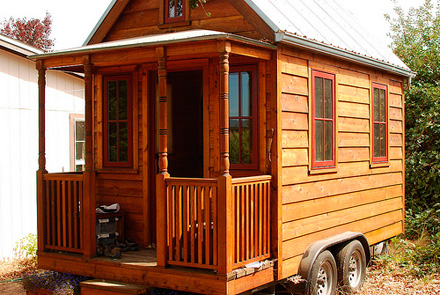The tiny house movement is a beautiful, constructive act of rebellion against a culture where overconsumption, going into debt and overwork are the norm.
A new way of life is finding its way into the hearts and minds of many who are tired of a system that fails miserably to provide for human happiness. Tiny houses contain within them the promise of a lifestyle that costs far less to maintain and allows for much greater mobility. Costing between $10,000 to $20,000 if you build them yourself, it also takes less to heat, cool and light them.
Also interesting is the idea that living smaller makes it easier for one to disconnect from corporate-induced patterns of overconsumption. With much less space to store unnecessary items, consuming merely for the sake of it simply becomes impossible. Perhaps it is this lifestyle shift that leads people like Jay Shafer, a pioneer of the tiny house movement, to view creating tiny houses as "a form of civil disobedience." And with the ability of the tiny house owner to attain a far greater degree of self-sufficiency, this way of life could be a most effective protest against the destructive way of living with the Earth that industrial civilization promotes.
Upstate in Chatham, NY, 34-year-old Aldo Lavaggi is elated to finally move into his self-designed tiny house, which took him two years to build. He observes that we are so "steeped in the idea that we can consume our way to happiness in American culture due to so much exposure to advertising" and has "a hunch that being challenged to live without the ability to consume a lot will lead to a variety of other riches."
Lavaggi's new home is equipped with a composting toilet and all his electrical needs are provided for by two solar panels which charge a battery pack. Using LED lighting, it takes only 50W to light his entire house. His house is also built on a trailer, so he can live anywhere he likes.
Lavaggi is interested in human happiness. He is fascinated by how, despite our high-tech lifestyle, "there's not a lot of happiness. In fact, we're less happy… people claim on surveys that they're less satisfied with their lives today than after World War 2." He thinks that this is "largely a result of becoming more isolated in our houses and not having the opportunity to do meaningful work." He sees the tiny house as a way to live more like the rest of the world – "there's no excess, just enough. That really gives you a sense of efficiency and not wastefulness – which is something we don't get to experience otherwise."
Lavaggi is also incredibly grateful for the generosity of Solaqua Power and Art, a Chatham-based company whose mission is "to integrate renewable energy and the arts, and promote a sustainable future through community education and revitalization." After facing much resistance to his early plans to build a tiny house, Solaqua finally provided the full support that Lavaggi needed to realize his dream. The company loaned him a space in their 100,000-square-foot warehouse at no cost and its sister company, Sundog Solar, offered him technical advice and insights. Solaqua are generously offering their resources and space in order to be an incubator for socially and ecologically responsible businesses. Inspired by the company's support, Lavaggi puts their cooperation in context: "As an economy relying on fossil fuels for cheap transportation and production becomes increasing expensive and hazardous, connected productive communities are what we have to fall back on. We should start creating this today."
Eventually, Lavaggi intends to become a consultant for tiny houses. His goal is not simply to run a business, but to make it easier for other people to live simply and sustainably. It is in this spirit that he offers to answer questions readers may have about tiny houses: email Aldo Lavaggi at tinyabode [at] gmail.com.
Image by nicolas.boullosa on Flickr, courtesy of Creative Commons Licensing.















